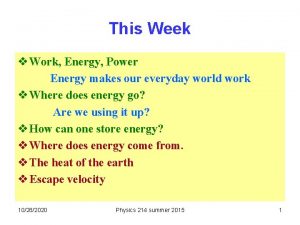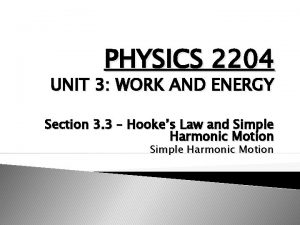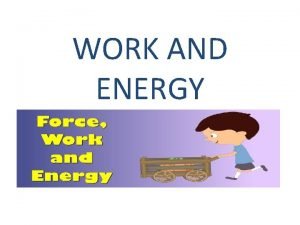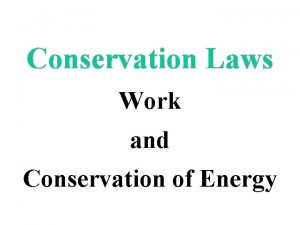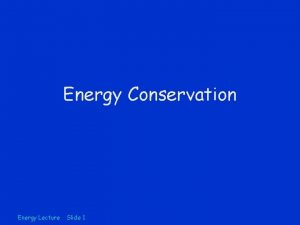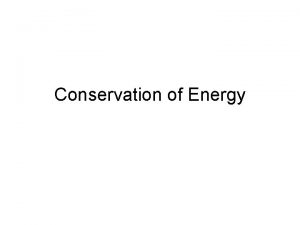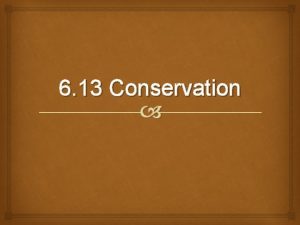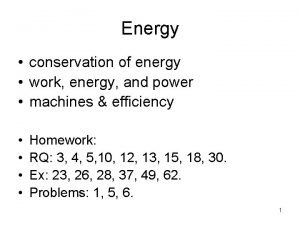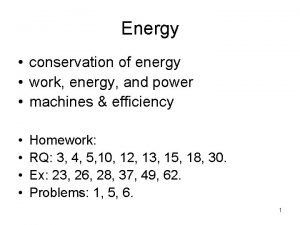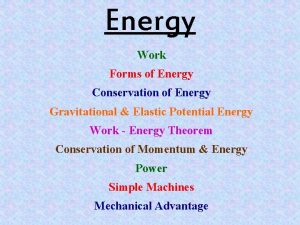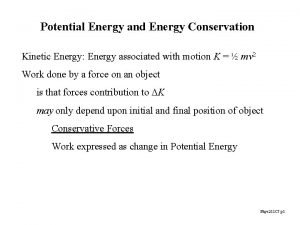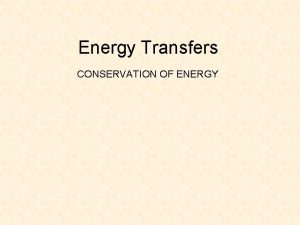Conservation of Energy Physics 112 Work In physics












- Slides: 12

Conservation of Energy Physics 112

Work • In physics, work is done on an object when a force causes a displacement of the object. • The formula is: W = Fd • F is the force acting parallel to the direction of motion. • d is the displacement, not the total distance. • W is the work done, it has the unit of energy called Joules, J. • 1 J of work is lifting an apple to the top of your head.

Positive and Negative Work • Work is a scalar quantity, meaning it is independent of the coordinate system. • However, it can be negative or positive. Its sign depends on the direction of the displacement. • When the force and displacement are in the same direction, work is positive. • When the force and the displacement are in the opposite direction, work is negative. • Applying the breaks to a car is an example of negative work. • Work done by kinetic friction is always negative.

Kinetic Energy, Ek • The energy associated with an object in motion. • Ek = ½mv 2 • m is the mass in kilograms and v is the object’s speed in m/s. The units of kinetic energy is Joules.

Gravitational Potential Energy, E • Potential g energy is stored energy. The object has the potential to move. • Associated with an object because of the position, shape, or condition of the object. • Gravitational potential energy depends on the height from a zero level. • The stored energy of an object due to its position relative to a gravitational source. • Eg = mgh • m is the mass in kg, g the acceleration due to gravity (9. 81 m/s 2) and h is the height above a zero level. • Eg is energy, so it is measured in Joules.

Elastic Potential Energy, Ee •

Conservative and Nonconservative Forces • Conservative Force: Does work on an object in such a way that the amount of work done is independent of the path taken. • Energy changes are reversible. • Nonconservative Force: The work done is pathdependent. • Kinetic friction is such a force. • May not be reversible.

Energy Transformations • Energy can be changed, or converted, from one type to another. • Dropping a book changes gravitational potential energy into kinetic. • Compressing a spring to shoot a toy gun changes Ee to Ek. • Law of Conservation of Energy: • Energy can neither be created nor destroyed, but it can be transformed from one form to another or transferred from one object to another. The total energy of an isolated system, including all forms of energy, always remains constant.

Applying Conservation of Total Energy •

Conservation of Energy: Conservative Forces • A roller coaster at a popular amusement park has a section as shown in the image. Assuming no friction, calculate the velocity at the top of the loop.

Conservation of Energy: Conservative Forces • A 5. 0 kg mass is dropped from a height of 3. 5 meters. The mass lands on a large spring and compresses it 0. 72 m to stop the mass. Calculate the spring constant, k.

Conservation of Energy: Nonconservative Forces
 Tan 22,5
Tan 22,5 Physics 03-06 impulse and momentum answer key
Physics 03-06 impulse and momentum answer key Chapter 7 energy conservation of energy
Chapter 7 energy conservation of energy 0kei0
0kei0 Kinetic energy formula
Kinetic energy formula Unit of resistivity
Unit of resistivity Physics 2204 unit 3: work, power, energy
Physics 2204 unit 3: work, power, energy Work energy theorem
Work energy theorem Mechanical energy
Mechanical energy Section 4 review physical science
Section 4 review physical science Section 2 describing energy worksheet answers
Section 2 describing energy worksheet answers Energy energy transfer and general energy analysis
Energy energy transfer and general energy analysis Energy energy transfer and general energy analysis
Energy energy transfer and general energy analysis




